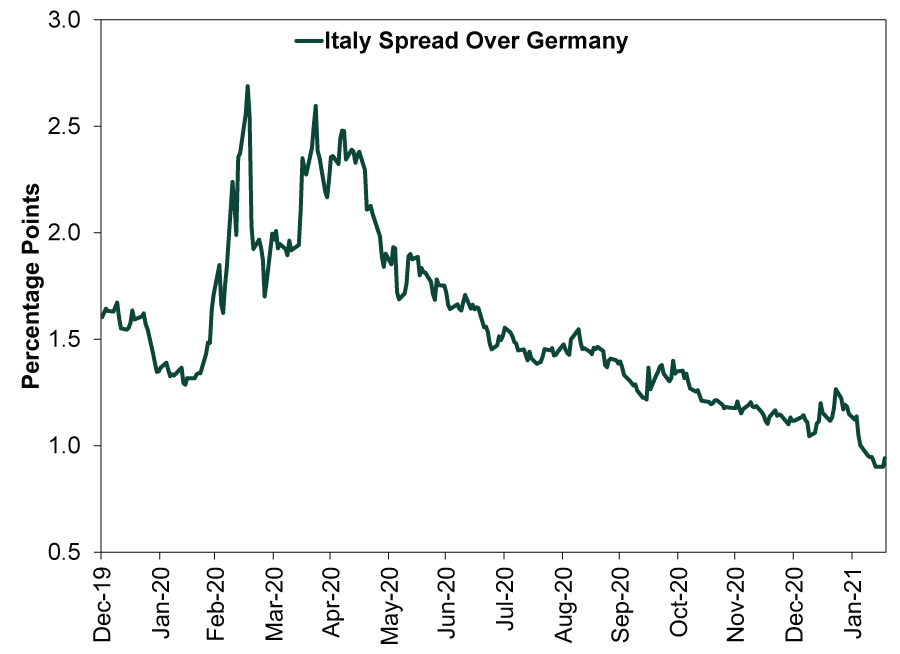Personal Wealth Management / Politics
‘Super’ Mario’s New Government Doesn’t Look Super Active
The more Italian prime ministers change, the more gridlock remains the same.
It is official. A little over a month after former Prime Minister Matteo Renzi and his small Italia Viva party withdrew from Italy’s multiparty coalition—leading to that coalition’s eventual dissolution—uncertainty over the shape of the country’s government fell this week. Former ECB head Mario Draghi—aka, “Super Mario”—is now Italy’s prime minister, charged with deploying EU coronavirus aid and leading a unity government comprised of virtually every major party in Italian politics. But while uncertainty is down and Draghi may have success in deploying EU aid, we think the government’s structure suggests Italian politics are as gridlocked as ever. Whether you are bullish or bearish on the idea of a much-heralded central banker leading the country, don’t overrate Draghi’s ability to enact big reforms and change—which should be fine for stocks.
Draghi’s victories in twin confidence votes—first Wednesday’s 262 – 40 in the Senate, then the 535 – 56 win in the Chamber of Deputies on Thursday—were decisive. He will head a broad-based government with the support of the Five-Star Movement, Lega, Democratic Party, Forza Italia and Renzi’s Italia Viva. Ministerial posts will be divided among these supporters, with a few going to non-partisan technocrats. As for the opposition, it chiefly comprises the far-right Brothers of Italy, who object to Draghi’s staunchly pro-EU line. They were joined by a group from the Five-Star Movement—a group the party now says it will eject, so we sort of figure Italy will have a new political party in Parliament soon. Regardless, though, Draghi’s new government has broad support at its dawn.
The new government’s chief task is determining how to spend €209 billion in EU coronavirus aid. Most plans loosely target aiding the tourism industry and health service in the near term, with green infrastructure, education and transportation spending getting larger, if longer-term, allocations. Disagreements over how to dole this money out were the proximate cause of the prior Prime Minister Giuseppe Conte government’s collapse. Now Italy ostensibly has until April 30 to present the EU with its plan, although we will note that EU politicians are extremely adept at moving self-imposed deadlines. Regardless, we figure the Draghi government could quite easily get a deal done on a non-contentious matter like this over the next month and a half or so.
Beyond that immediate task, though, we suspect Draghi’s government will face the same gridlock as its predecessors. In Draghi’s first major speech to Parliament this week, he touted citizens ceding more sovereignty to the EU—including a permanent, common EU budget charged with supporting the bloc in times of economic pressure. He also referenced sweeping tax and immigration reforms. These are all just general ideas, not legislation. But they are contentious ideas in Italy, meaning any associated measures would likely prove difficult to enact. The parties in Draghi’s coalition have quite disparate views of them, and getting consensus has proven extraordinarily difficult in Italy. All across Europe—in Holland, Germany, Spain and more—“big tent” coalitions that unite political opponents have proven incapable of passing big new laws.
Many now cite Draghi’s popularity and reputation for competence as reasons he will buck the trend and succeed in passing major reforms. Some even claim this is bullish, citing factors like the narrowing gap between Italy’s 10-year yield and Germany’s since his appointment shows investors have more confidence in a Draghi-run Italy. But as Exhibit 1 illustrates, that narrowing started after the lockdown-driven crisis inflated spreads last spring. Yes, spreads ticked higher when the Renzi-Conte spat started early this year and reversed as Draghi’s appointment reduced uncertainty. But that is a short-term wiggle amid a longer trend—we wouldn’t overthink it.
Exhibit 1: Italy 10-Year Spread Versus Germany

Source: FactSet, as of 2/18/2021.
A popular incoming technocrat isn’t unprecedented in Italy. Former Prime Minister Mario Monti’s appointment in 2011 was greeted with similar cheer. His technocratic government, installed at the height of the eurozone debt crisis, won confidence votes by a 281 – 25 margin in the Senate and 556 – 61 in the Chamber of Deputies. Only one party—Lega’s forerunner, the Northern League—opposed him. That is eerily similar to Draghi’s government now. Monti’s government accomplished relatively little and mostly stoked a backlash against unelected leaders that may have contributed to Italian populism’s rise.
Now, some observers note the outgoing Conte government had a penchant for meddling in corporate affairs—blocking foreign acquisitions of Italian firms, urging domestic mergers and using its control of the state lender, Cassa Depositi e Prestiti, to try to acquire the assets of some private firms.[i] Perhaps the potential end of that is a modest plus. But we see little evidence indicating it is a huge matter for stocks and would suggest Italy’s heavy value tilt explains its equity market’s relative underperformance versus the world better during Conte’s time at the country’s helm.
We strongly suspect that, beyond COVID aid decisions, Italy’s coalition will return to inactive infighting. The fragility of the country’s governments in recent years highlights that—it doesn’t undercut it. That inactivity means reforms—which nearly always create winners and losers, often bring unintended consequences and occasionally roil markets—aren’t likely. Gridlock, in our view, mitigates the risk a potential political negative strikes stocks.
[i] “Draghi Could End Italy’s Era of Corporate Interventionism,” Daniele Lepido and Chiara Albanese, Bloomberg, 2/17/2021.
If you would like to contact the editors responsible for this article, please message MarketMinder directly.
*The content contained in this article represents only the opinions and viewpoints of the Fisher Investments editorial staff.
Get a weekly roundup of our market insights
Sign up for our weekly e-mail newsletter.

You Imagine Your Future. We Help You Get There.
Are you ready to start your journey to a better financial future?

Where Might the Market Go Next?
Confidently tackle the market’s ups and downs with independent research and analysis that tells you where we think stocks are headed—and why.





